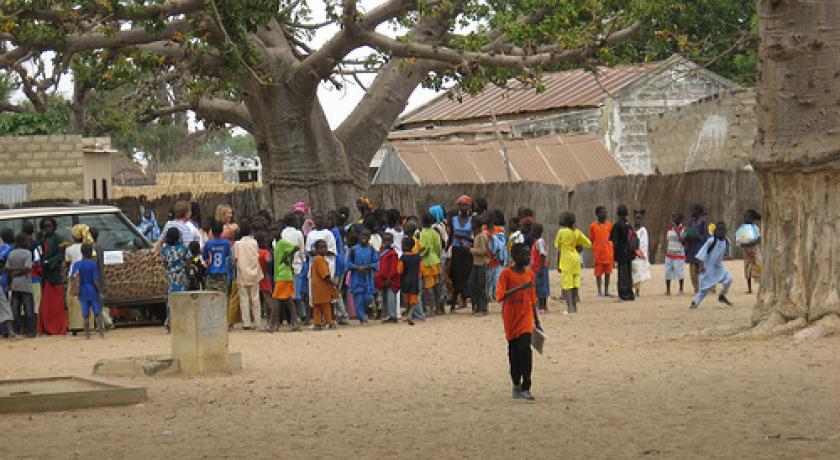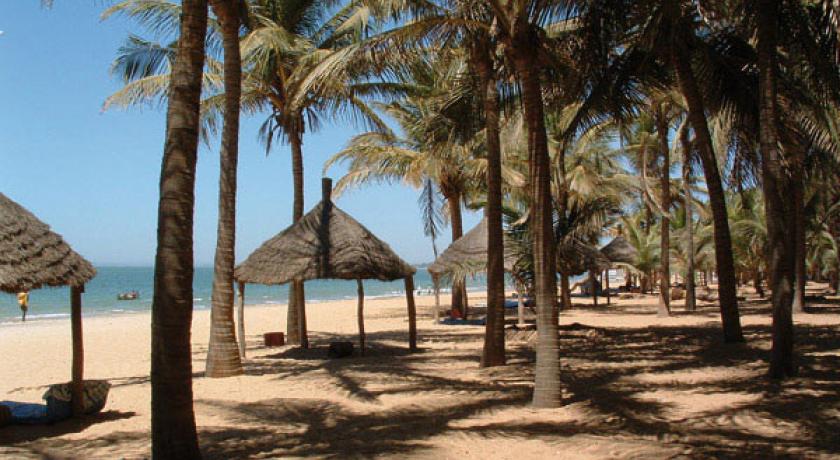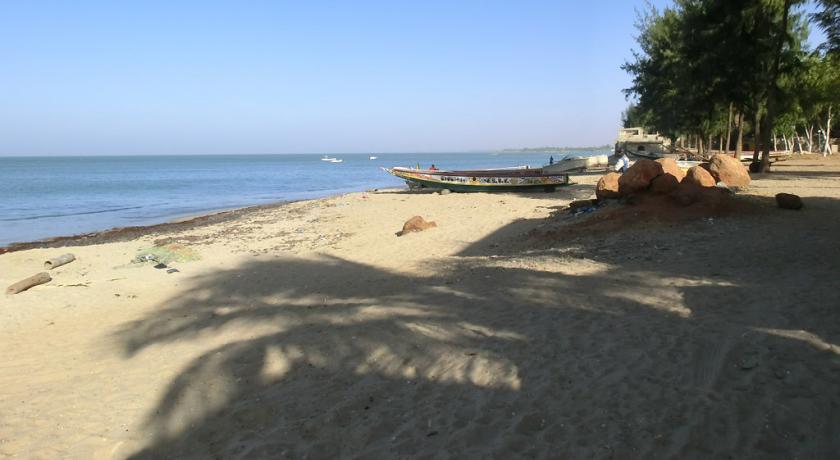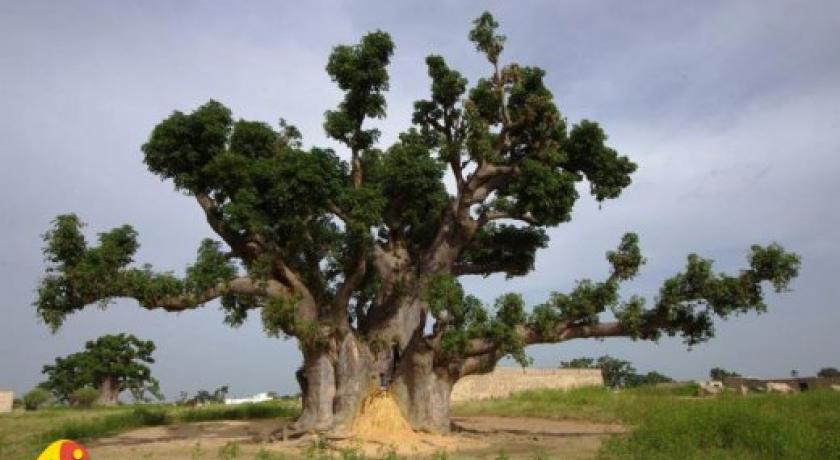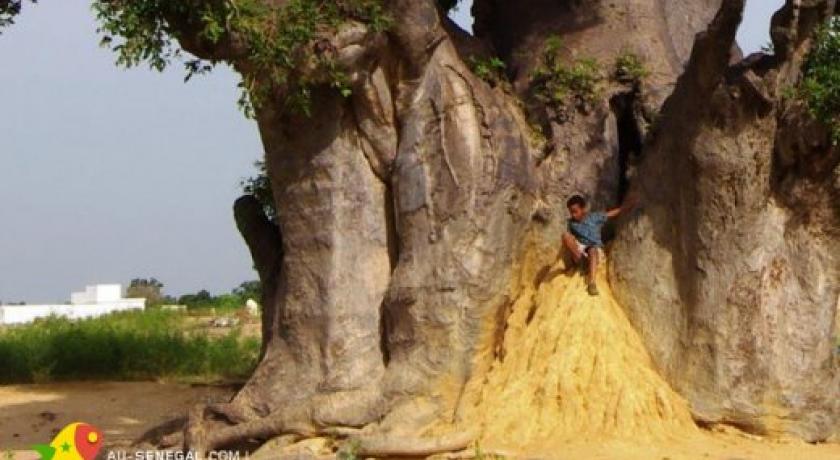Description
The village called Nianing is situated 10 km from Mbour on the Mbour-Joal road. It is 93 km from Dakar and 21 km from Joal. The village is located in the heart of the rural Community of Malicounda in the Region of Thiès. It counts more than 10,000 inhabitants of which the majorities are Sereer, Wolof, Fulani and Bambara. The economic activities turns around fishing, the transformation of halieutic products, agriculture, livestock, arts and crafts, small commerce, shell exploitation and tourism. Majority of the population engages in farming, livestock and fishing.
The sacred baobab tree of Nianing: the resting place of old griots sérères
In the heart of the large forest of the baobab trees in the village of Nianing, 8 km from Mbour, sits enthroned a baobab tree so impressive and mythical. Fascinating by its huge incomparable size, the tree has become a remarkable old cemetery for old griots sérères.
The interior of the sacred baobab tree in Nianing is accessible from its trunk which has an opening similar to the door of a cave. The heart of several generations of griots floods here, like invisible archives of the orals.
A PLACE BANISHED LONG AGO
Witness of this soft and peaceful Sérère city, the sacred baobab tree of Nianing was used exclusively as a cemetery for the griots, considered as beings of the lower classes. Thus, the Sérère tradition does not permit that the griots be buried, a story that ‘’must not pollute”, their land, the place was choosen like a polling booth these dead.
Wrapped in a white shroud, the dead griot will be introduced into the hollow space of the tree trunk. Women at the entry, men at the end and children, in a kind of a mini room inside. They could convince theirs to hang their musical instruments on the spot. This belief and this fate concerning the griots, made of this site, a banished space, where nobody was to hang around…
THE END OF ITS STATUTE AS A VOTING BOOTH
The place is venerated and regarded as a sacred place since the population stopped making it a cemetery for the griots, following a veto, from president Léopold Sédar Senghor. He made them understand that the griots did not deserve such a fate, but also that this practice was dangerous because a decomposed corpse could provoke an epidemie. After a few years of confrontation, the president poet of then, who is from the same ethnic group, ended up convincing them, at the dawn of independence. In the course of time, the tree became a popular place and receives guests who come from far and near for diverse reasons.
A PLACE OF ATTRACTION AND MYSTICAL BELIEF
Captivating with a single sight of about 32meters in diameter, this 18 centuries old baobab tree, has gained respect and admiration, from its past history. Banished long
ago, the tree is now, a place of attraction. A true temple with various fortunes. An attractive symbol, tourists come from far and wide to contemplate and communicate with this nature’s giant. Emotions are largely felt here where the souls of the departed griots is floods.
The sacred baobab tree is also visited by the local populations for these supposed mystica land miraculous virtues. By respecting a certain number of ritual and mystical baths, the believer can see his health issues, or fertility problem being solved…
HISTORY
The name “Nianing” (Ñaaning) comes from the preferred dish of the Sereers, the “Ñaleng”, a type of millet, mixed with groundnut powder, and with condiments. History says that a colonizer, visiting the village in 1902, found a woman cooking. He questioned the latter on the name of the village. The woman pronounced “Ñaleng”, thinking that the question was directed towards the met in preparation.The European foot-note “Nianing” and this word, badly written and badly pronounced, remained as the name of the village.
This village was a small hamlet of the province of Sine. There were only populated forests of hyenas, jackals, etc the inhabitants were devoted to agriculture of groundnut and millet. Hunting was also practised. The fishermen came much later from Kayar, Yeen, Bargny. They resided a few days during their fishing exploration.
After the departure of the Portuguese, the French came to settle in the village with companies such as Maurel and PROM, Nosoco, SCOA.
The house of the Commander of the circle, inhas been raised into a place of Residence, presently a social rehabilitation center social.
The first inhabitants of Nianing identified themselves around 1750, with the installation of a port. From 1772 to 1885, various products transited there: groundnut, millet, cotton, shea butter coming from Sudan (Mali). This port recorded the greatest economic activity of the Small Coast, of Sine in Djeggëm, Mbadanie to Sine Saloum, all the big groundnut dealers came there to weigh and sell their products to the colonists.
Today the small town is located on the main road which leads from Mbour to Joal-Fadiouth.
ECONOMY
Fishing constitutes the first local resource. Livestock can also be added, agriculture, trading and tourism is part of it now. The domain of Nianing is a
very beautiful resort in a beautiful park. It has tourist campings like Oasis, Bentenier, Girafon.
Source http://www.au-senegal.com/le-baobab-sacre-de-nianing-ici-reposent-les-anciens-griots-sereres,11299.htmland https://fr.wikipedia.org/wiki/Nianing
Address
Nianing
Senegal
Lat: 14.338523865 - Lng: -16.927005768


